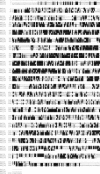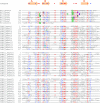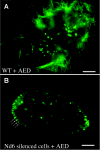Nd6p, a novel protein with RCC1-like domains involved in exocytosis in Paramecium tetraurelia
- PMID: 16339730
- PMCID: PMC1317492
- DOI: 10.1128/EC.4.12.2129-2139.2005
Nd6p, a novel protein with RCC1-like domains involved in exocytosis in Paramecium tetraurelia
Abstract
In Paramecium tetraurelia, the regulated secretory pathway of dense core granules called trichocysts can be altered by mutation and genetically studied. Seventeen nondischarge (ND) genes controlling exocytosis have already been identified by a genetic approach. The site of action of the studied mutations is one of the three compartments, the cytosol, trichocyst, or plasma membrane. The only ND genes cloned to date correspond to mutants affected in the cytosol or in the trichocyst compartment. In this work, we investigated a representative of the third compartment, the plasma membrane, by cloning the ND6 gene. This gene encodes a 1,925-amino-acid protein containing two domains homologous to the regulator of chromosome condensation 1 (RCC1). In parallel, 10 new alleles of the ND6 gene were isolated. Nine of the 12 available mutations mapped in the RCC1-like domains, showing their importance for the Nd6 protein (Nd6p) function. The RCC1 protein is well known for its guanine exchange factor activity towards the small GTPase Ran but also for its involvement in membrane fusion during nuclear envelope assembly. Other proteins with RCC1-like domains are also involved in intracellular membrane fusion, but none has been described yet as involved in exocytosis. The case of Nd6p is thus the first report of such a protein with a documented role in exocytosis.
Figures






Similar articles
-
Novel secretory vesicle proteins essential for membrane fusion display extracellular-matrix domains.Traffic. 2004 Jul;5(7):493-502. doi: 10.1111/j.1600-0854.2004.00194.x. Traffic. 2004. PMID: 15180826
-
Molecular identification of 26 syntaxin genes and their assignment to the different trafficking pathways in Paramecium.Traffic. 2007 May;8(5):523-42. doi: 10.1111/j.1600-0854.2007.00544.x. Traffic. 2007. PMID: 17451555
-
The actin multigene family of Paramecium tetraurelia.BMC Genomics. 2007 Mar 28;8:82. doi: 10.1186/1471-2164-8-82. BMC Genomics. 2007. PMID: 17391512 Free PMC article.
-
Aspects of signal transduction in stimulus exocytosis-coupling in Paramecium.J Cell Biochem. 1988 Apr;36(4):429-43. doi: 10.1002/jcb.240360411. J Cell Biochem. 1988. PMID: 2454239 Review.
-
Trichocysts-Paramecium's Projectile-like Secretory Organelles: Reappraisal of their Biogenesis, Composition, Intracellular Transport, and Possible Functions.J Eukaryot Microbiol. 2017 Jan;64(1):106-133. doi: 10.1111/jeu.12332. Epub 2016 Jul 18. J Eukaryot Microbiol. 2017. PMID: 27251227 Review.
Cited by
-
An Alveolata secretory machinery adapted to parasite host cell invasion.Nat Microbiol. 2021 Apr;6(4):425-434. doi: 10.1038/s41564-020-00854-z. Epub 2021 Jan 25. Nat Microbiol. 2021. PMID: 33495622 Free PMC article.
-
Whole Genome Sequencing Identifies a Novel Factor Required for Secretory Granule Maturation in Tetrahymena thermophila.G3 (Bethesda). 2016 Aug 9;6(8):2505-16. doi: 10.1534/g3.116.028878. G3 (Bethesda). 2016. PMID: 27317773 Free PMC article.
-
An evolutionary balance: conservation vs innovation in ciliate membrane trafficking.Traffic. 2017 Jan;18(1):18-28. doi: 10.1111/tra.12450. Epub 2016 Oct 27. Traffic. 2017. PMID: 27696651 Free PMC article. Review.
-
A central CRMP complex essential for invasion in Toxoplasma gondii.PLoS Biol. 2023 Jan 5;21(1):e3001937. doi: 10.1371/journal.pbio.3001937. eCollection 2023 Jan. PLoS Biol. 2023. PMID: 36602948 Free PMC article.
-
Functional Characterization of the Thrombospondin-Related Paralogous Proteins Rhoptry Discharge Factors 1 and 2 Unveils Phenotypic Plasticity in Toxoplasma gondii Rhoptry Exocytosis.Front Microbiol. 2022 Jun 9;13:899243. doi: 10.3389/fmicb.2022.899243. eCollection 2022. Front Microbiol. 2022. PMID: 35756016 Free PMC article.
References
-
- Aebi, M., M. W. Clark, U. Vijayraghavan, and J. Abelson. 1990. A yeast mutant, PRP20, altered in mRNA metabolism and maintenance of the nuclear structure, is defective in a gene homologous to the human gene RCC1 which is involved in the control of chromosome condensation. Mol. Gen. Genet. 224:72-80. - PubMed
-
- Aufderheide, K. 1978. The effective sites of some mutations affecting exocytosis in Paramecium tetraurelia. Mol. Gen. Genet. 165:199-205.
-
- Aufderheide, K. J. 1978. Genetic aspects of intracellular motility: cortical localization and insertion of trichocysts in Paramecium tetraurelia. J. Cell Sci. 31:259-273. - PubMed
-
- Aufderheide, K. J. 1978. Motility events of trichocyst insertion in Paramecium tetraurelia. J. Protozool. 25:362-365. - PubMed
Publication types
MeSH terms
Substances
LinkOut - more resources
Full Text Sources
Miscellaneous

